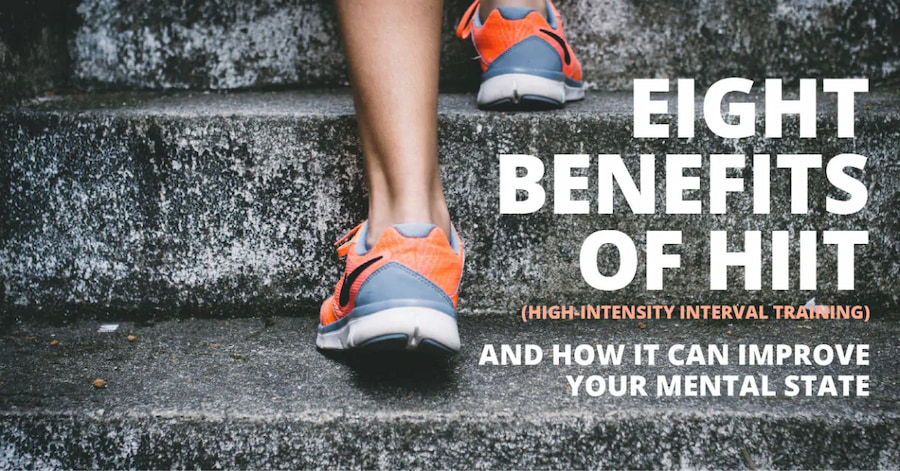
8 Benefits of High-Intensity Interval Training (HIIT) and how it can improve your mental state
High Intensity Interval Training (HIIT), also commonly known as interval training, is a popular training protocol, and an effective way to burn fat and calories in a short period of time.
HIIT is characterised by bursts of intense exercise followed by rest periods to allow the body to recover enough to begin the next high-intensity interval. To have maximum effect, the bursts should be challenging and the rest periods kept to a minimum (i.e. just long enough to allow the body to recover to complete the next set.
While serious athletes have long known the benefits of HIIT, recent years have seen the training method spread like wildfire among the wider community.
For years the norm was, exercise focused on continuous training, at medium intensity for a long period of time. However, research (1) demonstrates that, while medium-intensity aerobic training increases a person’s maximal aerobic power (a measure of endurance and cardio fitness), it doesn’t alter anaerobic capacity (ability to repeat production of power with short breaks in between). What’s more, adequate high-intensity intermittent training may significantly improve both anaerobic and aerobic energy supplying systems.
Around the world, increasing numbers of researchers and sports professionals are advocating HIIT training and waxing lyrical about its merits. Here are 8 good reasons why:
1. It’s efficient
HIIT is the ideal workout for a busy schedule, with research highlighting its ability to burn calories quickly (2). In fact, one such study found that 30 minutes of HIT burned up to 30% more calories compared with the same time spent weight training, running and biking. Because of this elevated impact, HIIT workouts tend to be much shorter than traditional exercise sessions.
Indeed, a further recent study discovered that twelve weeks of 10 minute HIIT improved cardio health the same amount as traditional endurance training of 50-minute sessions, despite 40 minutes less time spent in exercise volume and time commitment per session.
2. Improves cardiovascular health
Many studies are now showing that HIIT workouts promote greater improvements in VO2 max and general fitness abilities compared to steady-state exercises (3).
VO2 max is considered the best indicator of cardiovascular endurance. It’s used to demonstrate the effects of exercise on the body and how well the body uses oxygen for energy.
By pushing your heart rate high during periods of intense workout, you’ll be able to increase your cardiovascular ability and strengthen your heart. During the short rest intervals, you work on recovering more quickly and needing less time to rest, helping you to build stamina over time and perform physical exercise more efficiently.
3. Anti-ageing
According to a 2012 pilot study, a direct relationship exists between physical activity and anti-ageing (5), with HIIT exercise in particular activating an increase in telomerase, a known anti-ageing enzyme. Other anti-ageing benefits of HIIT include firmer skin, fewer wrinkles and improved muscle tone.
4. Reaping rewards, even hours after exercise
Because of its high intensity, HIIT can elevate your metabolism for several hours after exercise (6). Essentially, the higher the intensity, the longer it takes your body to repair and return your metabolism to a normal, resting state. It’s during this recovery process that you continue to burn extra calories.
5. Helps to balance hormones
Research suggests HIIT can help balance the hormones responsible for weight gain and unhealthy eating habits – ghrelin and leptin.
A small study (7) determined that when a group of overweight men performed 30 minutes of HIIT versus performing the same amount of moderate-intensity exercise, they consumed fewer calories following their workout. This is likely because HIIT exercise reduces the production of ghrelin (known as the ‘hunger hormone’), which stimulates appetite. It also increases levels of blood lactate and blood glucose, which squash short-term appetite.
6. You can do it anywhere, any time
Running, high knees, fast feet, jumping squats and jumping jacks all work great as part of HIIT workouts, as they help to get your heart rate up fast. Being such a straight-forward, equipment-free, concept, you can adapt it to whatever time and space you have available.
7. Blood-sugar balance
Studies have shown that resistance-based HIIT benefits blood flow and blood vessel dilation.
An examination of fifty studies found that HIIT reduces blood sugar and improves insulin resistance more than traditional continuous exercise (8).
This highlights that HIIT is particularly beneficial for those at risk of type 2 diabetes, with some studies on sufferers showing the success of HIIT in improving blood sugar.
8. Lose weight, not muscle
HIIT circuits trigger muscle-building hormones while at the same time using up calories and burning fat. The body produces the growth hormone, IGF-1 during HIIT, which supports the body in building lean mass muscle.
HIIT and mental health
Science clearly shows moving can help stimulate your happy hormones, including serotonin, which is why you feel great after a good workout. And not many things trigger a flood of happiness faster than HIIT.
Research into intense exercise such as HIIT suggests it may be able to help ward off depression as well as supporting existing sufferers (9). One study showed that vigorous exercise increases the levels of two common neurotransmitters called glutamate and GABA, which are in charge of chemical messaging in the brain. This is important as major depressive disorders are regularly linked with depleted levels of both of these neurotransmitters.
Similarly, a second study (10) reported that HIIT can alter your brain by boosting a protein called BDNF, which is involved in regulating brain function and mood. Low levels of BDNF are associated with depression, bipolar disorder and schizophrenia; this suggests that HIIT can help with mood regulation and increased brain function.
Anyone can work towards practising HIIT to reap both the physical and mental health rewards. However, if you aren’t already exercising, it’s important to start slowly to avoid injury. And remember: you cannot exercise your way out of a poor diet, so make sure to consume a healthy, balanced diet with as few processed foods as possible.
References:Tabata I, et al. (2019). ‘Effects of moderate-intensity endurance and high-intensity intermittent training on anaerobic capacity and VO2max.’ – PubMed – NCBI. [online] Available at: https://pubmed.ncbi.nlm.nih.gov/8897392/ [Accessed 15 Oct. 2019]Falcone PH, et al. (2019). Caloric expenditure of aerobic, resistance, or combined high-intensity interval training using a hydraulic resistance system in healthy men. PubMed – NCBI. [online] Available at: https://pubmed.ncbi.nlm.nih.gov/25162652/ [Accessed 15 Oct. 2019]
1) Batacan, R.B., Duncan, M.J., Dalbo, V.J., Tucker, P.S. and Fenning, A.S. (2016). Effects of high-intensity interval training on cardiometabolic health: a systematic review and meta-analysis of intervention studies. British Journal of Sports Medicine, 51(6), p.494–503
2) Gillen JB, Martin BJ, MacInnis MJ, Skelly LE, Tarnopolsky MA, Gibala MJ (2016) Twelve Weeks of Sprint Interval Training Improves Indices of Cardiometabolic Health Similar to Traditional Endurance Training despite a Five-Fold Lower Exercise Volume and Time Commitment. PLOS ONE, 11(4) [Online]. Available at https://doi.org/10.1371/journal.pone.0154075 [Accessed: 14 October 2019]
3) Werner, C, et al., (2012) High-Intensity Interval Training Activates Telomerase and Reduces P53 Expression. Circulation, 126(21), [Online]. Available at https://www.ahajournals.org/doi/abs/10.1161/circ.126.suppl_21.a18220 [Accessed: 14 October 2019]
4) Wingfield, H.L., Smith-Ryan, A.E., Melvin, M.N., Roelofs, E.J., Trexler, E.T., Hackney, A.C., Weaver, M.A. and Ryan, E.D. (2015). The acute effect of exercise modality and nutrition manipulations on post-exercise resting energy expenditure and respiratory exchange ratio in women: a randomized trial. Sports Medicine – Open, 1(1) [Online]. Available at https://pubmed.ncbi.nlm.nih.gov/26213682/ [Accessed: 16 October 2019]
5) Sim, A Y, et al. (2005) “High-Intensity Intermittent Exercise Attenuates Ad-Libitum Energy Intake.” International Journal of Obesity, vol. 38, no. 3, 2014, pp. 417–22 [Online]. Available at https://pubmed.ncbi.nlm.nih.gov/23835594/[Accessed: 15 October 2019]
6) Jelleyman, C., Yates, T., O’Donovan, G., Gray, L.J., King, J.A., Khunti, K. and Davies, M.J. (2015). The effects of high-intensity interval training on glucose regulation and insulin resistance: a meta-analysis. Obesity reviews : an official journal of the International Association for the Study of Obesity, [online] 16(11), pp.942–61. Available at https://pubmed.ncbi.nlm.nih.gov/26481101/ [Accessed 16 Oct. 2019]
7) This Is Your Brain on Exercise: Vigorous Exercise Boosts Critical Neurotransmitters, May Help Restore Mental Health. ScienceDaily, [Online]. Available at www.sciencedaily.com/releases/2016/02/160225101241.htm. [Accessed 16 Oct. 2019]
8) Hwang, Jungyun, et al. (2016) “Acute High-Intensity Exercise-Induced Cognitive Enhancement and Brain-Derived Neurotrophic Factor in Young, Healthy Adults.” Neuroscience Letters, vol. 630, 2016, pp. 247–253, [Online] https://pubmed.ncbi.nlm.nih.gov/27450438/ [Accessed 16 Oct. 2019]


